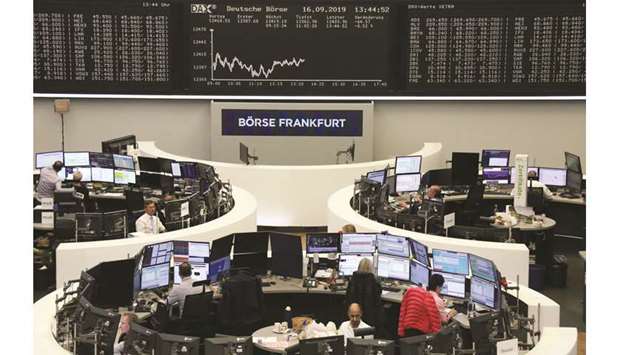Oil prices saw their biggest daily gain since the 1991 Gulf War yesterday after drone attacks on two Saudi oil facilities halved output in the world’s top crude exporter, fuelling fresh geopolitical and growth fears.
Europe’s benchmark Brent crude surged by 20% and US counterpart WTI by 15% as commodities trading got underway after President Donald Trump warned that the US was “locked and loaded” to respond to the attacks that Washington blamed on Iran.
In Europe, London’s FTSE 100 was down 0.6 % at 7,321.41 points and Frankfurt’s DAX 30 lost 0.7 % at 12,380.31 and Paris’s CAC 40 slipped 0.9 % to 5,602.23 points at the close yesterday.
Both contracts later came off their peaks, but were still up around 12% at the close of European trading.
The price surges weighed across world stock markets on fears that a sustained higher cost of crude could impact already weakening global economic growth.
“Growing tensions in the Middle East are another headwind for the global economy in already uncertain times and a full-blown conflict could trigger another leg in the global downturn,” said Jennifer McKeown, head of Global Economics at Capital Economics.
However, share prices of energy majors jumped, with traders seeing higher profits down the line for the likes of BP and Shell.
In foreign exchange, the dollar was down against the yen and up against the euro, while the pound slid, with the EU saying that Britain had offered no new, viable Brexit proposals after Prime Minister Boris Johnson held Brexit deal talks with EU chief Jean-Claude Juncker.
Gold, which along with the yen is seen as a haven in times of geopolitical and economic unrest, rose.
Markets’ focus was firmly on oil however after the weekend attack that was claimed by Tehran-backed Houthi rebels in neighbouring Yemen, where a Saudi-led coalition is bogged down in a five-year war.
“Oil price shocks like this are bad news for growth,” Neil Wilson, chief market analyst at trading group Markets.com, told AFP.
“It raises stagflation risks too – higher oil prices suppress growth and raise inflation.
Of course it depends how long this lasts, does the risk-premium mean higher prices for the rest of the year or does it fade quickly if it comes back on stream this week?”
Saudi Arabia was yesterday expected to restore at least a third of the production lost to the attacks, according to experts and reports.
The Saturday strikes on national energy giant Aramco’s Abqaiq processing plant and Khurais oil field knocked 5.7mn barrels per day off production, more than half of the Opec kingpin’s output.
Saudi Energy Minister Prince Abdulaziz bin Salman on Sunday said the kingdom would use its vast inventories to partially compensate for the lost production and the US also authorised the release of its reserves.
“The attack wiped out around half of Saudi Arabia’s production – representing around 5% of global daily output – and highlighted the vulnerability of security at these facilities to drone attacks,” noted Oanda senior market analyst Craig Erlam.
“Spikes in oil prices when the global economy is already flirting with the idea of recession is not ideal and, if repeated and sustained, could ultimately be what tips us over the edge,” he added.
Facing a dauntingly uncertain economic horizon amid the US-China trade war, the Federal Reserve is set to cut interest rates this coming week, analysts predicted.

The German share price index DAX graph is seen at the Frankfurt Stock Exchange. The DAX 30 lost 0.7% to 12,380.31 points yesterday.


